- Details
- Written by: Mike Walker
I’m standing in the dark, about two metres under the ground, touching a soft, wet object and trying to work out what on Earth it is. Probably some sort of fungus, guess my guides – staff from the Lincolnshire Wolds Area of Outstanding Natural Beauty (AONB) – as they shine their mobile phones on the alien-like life forms hanging from the ceiling. None of us really know as it’s the first time any of us have been down into this Second World War RAF bunker.
This might seem an unlikely place to end up in on a tour of an AONB, but the Lincolnshire Wolds are covered in old airfields. ‘With a top height of 168 metres, the Wolds are the highest point on the east coast between the Yorkshire Moors and the Kent Downs,’ says Helen Gamble, AONB project officer.’ So it was an important defence site during the war.’
The 558 square kilometres of chalk-topped hills were designated as an AONB in 1973, and the airfields were seen as a plus rather than a minus. ‘It’s a really worked landscape,’ says Gamble. ‘It was one of the reasons it was designated. The bones of the landscape are fleshed out with how they’ve been used by people.’
HIGHLY FASHIONABLE
Originally formed around 150 million years ago the Wolds were later ravaged by glaciers, leaving a rolling landscape of rounded hills and wide, ice-scoured valleys. Their gentle contours appealed to farmers, and agriculture has been a defining feature of the landscape ever since. In fact, as we drive around the Wolds, the only people we see for hours are a farmer driving his sheep across a road and a butcher sharpening his knives in a shop window.
But it wasn’t always so empty. ‘During the Middle Ages, it was highly fashionable,’ says David Start, director of the Heritage Trust of Lincolnshire. The county’s wealth, he explains, was based on the good farming available and the region’s easy accessibility before the modern road system was built. ‘It was a really busy county.’
Just how busy was revealed when early aviators looked down and realised the strange shapes in the fields below were the remains of deserted medieval villages. Indeed, the region has one of the highest concentrations of such villages in Britain. ‘There are 235 in Lincolnshire and more than half of them are in the Wolds,’ says Start. Their discovery led to a revolution in British archaeology and the creation of a whole new field of study during the 1950s. ‘Before that time, they would dig through the medieval archaeology to get to the “proper stuff” – the Roman remains,’ says Start. ‘Even in my day, we referred to the medieval stuff as “overburden”.’
Various theories were put forward, to explain why the villages were abandoned, including climate change and the Black Death. Start says that these contributed to the exodus, but the real problem was sheep. ‘Sheep killed the villages,’ he says. ‘From the 12th century onwards, the wool trade became a very lucrative business. Farming sheep was much more profitable and much less hassle than a load of peasants.’ As a result, they were kicked off their land and forced into other villages. ‘It literally changed the English landscape.’
And there was little the peasants could do to resist. ‘You and your family were as much owned as the land,’ says Start. The villages were
set up as a collection of rented croft smallholdings surrounded by rented fields divided into strips known as ridge and furrows, he explains. ‘You paid for your strips in the field and your little bit of smallholding by giving a proportion of your crops to the lord. You could take on more strips if you could find the money, and had enough sons to farm them, but the lord could still chuck you off whenever he wanted.’
Despite the lack of security, the villages were still their residents’ entire world. ‘Many would be born, marry and die in the same village,’ says Start. ‘If you stand in one of the streets today, you can almost hear them.’ Perhaps, but it’s easier to spot the visible evidence of their lives.
Under the grass, you can make out the borders of smallholdings and the sunken roads or holloways worn down by people and animals. Keep your eyes down and you might even spot the odd shard of pottery. ‘Look in the molehills,’ says Start. ‘They’re the archaeologist’s best friends.’
Continued...
 STREAM TEAM
STREAM TEAM
Although nobody will ever know exactly why each village was abandoned, what initially attracted people to a location is easier to determine. ‘A village needs land that’s good enough to provide a range of arable and stock farming, it needs to be reasonably defendable and it needs a water supply,’ says Start. In the Lincolnshire Wolds, water usually means a chalk stream. These unique habitats are only found in a few places in the world and are more common in England than anywhere else. Widely considered the quintessential English stream, they’re gin-clear and shallow, with a gravel bed.
Their clarity is the result of the way in which they form. Most river and stream water is cloudy because of the sediment picked up by rainwater as it flows across a landscape and into the stream. But chalk streams are clear because their rainwater is filtered by the chalk hills before it reappears at a spring months later. ‘And because you have this buffering effect of the chalk, they don’t rise and fall with individual rain events but instead slowly rise and fall with the seasons,’ says Ian Rees, chalk streams project officer. ‘As a result, most never dry up, and many have been flowing for thousands of years.’
Their temperature is constant too. ‘Eleven degrees throughout the year,’ says Rees. ‘In summer, that’s cold but in winter it’s warm. If you come down here on a frosty morning, you’ll see tendrils of mist rising up off the water.’
All this consistency makes them a haven for wildlife. Voles and otters live along the banks; fish such as grayling and bullhead live in the water; and, perhaps most importantly, brown trout spawn in the gravel.
But all of these species are reliant on the unique characteristics of the streams, and these are threatened by human interference. Over the centuries, the streams have been straightened to redirect the water for drinking, power or drainage. With their energy increased, they then cut into the ground, causing the banks to rise and steepen. When these banks subsequently crumble into the stream, the water turns murky and the stream beds silt up. This is disastrous for the trout, which lay their eggs in the gravel and whose young hatchlings use the gaps between pebbles to develop in before launching into the stream ‘If you have a lot of silt within the system, you smother them,’ says Rees.
Rees has been working with local farmers to try to restore these precious habitats. ’People just see them as ditches because that’s what they’ve been used for,’ says Rees. ‘I’m trying to reawaken people’s interest in them.’
With 80 per cent of the Wolds ‘under the plough’, one of the big threats to the streams is the water running off the fields, which often carries sediment and nutrients.To prevent this, Rees encourages farmers to manage their land more sympathetically. This can include ploughing along a contour, rather than across it. This prevents gullies forming and creates a ladder of earth barriers that keep the sediment on the land where it belongs.
He also advises farmers on how to manage the streams. Previously, many widened them and raked out the plants, thinking it would make the stream run faster. ‘But it doesn’t,’ says Rees. ‘It slows it down. It’s like a hose pipe: if you make it twice as large, the pressure is half as much and the water just dribbles out.’ Instead, Rees and his team add bundles of brushwood to stream banks to make them smaller. The water then travels more quickly and scours out any sediment. The result is an appealing habitat for spawning trout.
But the trout also need flies to eat, and the flies need somewhere to live. Which is why Rees has been planting the streams with water crowfoot, a buttercup-like plant that roots itself in the gravel and provides a home for insects. ‘We planted some here two years ago and it has spread like wildfire,’ says Rees as we stand beside a lovely clear chalk stream.
The result has been a remarkable increase in invertebrate diversity in the streams. ‘Before we started the project, there were just 14 different species of invertebrate. At the last count, there were 44,’ says Rees. ‘Recently, some rare stonefly species have even been counted. They don’t live in polluted water, so it’s a good indication something is working.’
EVOLVING LANDSCAPE
The farmers are given support for this type of work through the government’s environmental stewardship scheme, a tiered system designed to replace farm subsidies and help farmers become more environmentally friendly. Farmers
are partially paid for work they carry out on their land, such as allowing access to deserted medieval villages, recreating species-rich grassland, managing chalk streams correctly or ploughing less deeply to protect archaeological remains.
But it’s a complicated system, according Gamble, who‘s concerned a lack of funds will mean that not all of the Wolds’ farmers will make the grade. She feels this would be disappointing’ as most care about the landscape and still farm traditionally, rotating the crops on a five-year basis. ‘On a landscape scale, wouldn’t it be better to have 20 farmers working at a lower level but still bringing benefits to the whole area, rather than five farmers working really hard but in isolation?’ she asks. But she still encourages farmers to join the schemes so their green initiatives can be supported and the Lincolnshire Wolds can protect and enhance its biodiversity, historic features and access. ‘We try to work with the farmers to enhance the landscape,’ says Gamble. ‘It’s a landscape that has evolved over centuries, and we want to see it continue to evolve.
LOCAL KNOWLEDGE: top tips for trips to the Lincolnshire Wolds
- Red Hill, an unusual red chalk escarpment with views to Lincoln cathedral. ‘It’s such a stunning site, and covered in flowers and butterflies during the summer,’ says Helen Gamble, AONB project officer
- Hubbards Hill, a park through which the River Lud runs, on the edge of the market town of Louth. ‘It’s a great place to relax, and on a summer’s day, you’ll see people paddling in the water,’ says Ian Rees,chalk stream project officer
- The deserted medieval villages of Calcethorpe and South Cadeby. ‘They’re only about a mile and a half apart, so it’s easy to walk between the two,’ says David Start, director of the Heritage Trust of Lincolnshire
- Mill Hill, an old quarry works good for spotting orchids and birds of prey. ‘As the farmers couldn’t reach the bottom, it’s a really nice example of what the Wolds used to look like,’ says Kevin James, Lincolnshire Wildlife Trust area warden
Find out more at www.lincswolds.org.uk

 Area of Outstanding Natural Beauty...
Area of Outstanding Natural Beauty...

